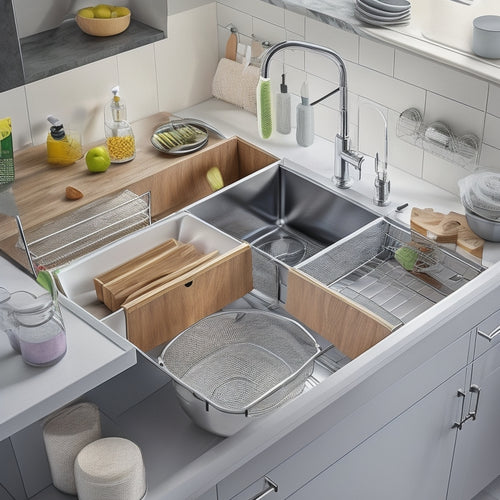
7 Best Decluttering Secrets for a Calm Kitchen
Share
You can achieve a calm kitchen by starting with a thorough purge of unwanted items, categorizing them into keep, donate/sell, or toss piles. Designate zones for food prep, cooking, and cleaning tasks to improve efficiency. Optimize cabinet storage space with wall-mounted shelves, organizers, and labels. Clear countertops of clutter by positioning frequently used items nearby and utilizing vertical storage options like shelves, hooks, and pegboards. Create a landing strip station for keys, mail, and bags, and establish a daily maintenance routine to prevent clutter accumulation. By following these secrets, you'll be well on your way to a peaceful kitchen - and there's more to explore to get you there.
Key Takeaways
• Categorize kitchen items into keep, donate/sell, and toss piles to purge unwanted clutter and free up space.
• Designate zones for food prep, cooking, and cleaning tasks to improve efficiency and reduce stress.
• Utilize vertical storage options like shelves, hooks, and pegboards to maximize space and keep countertops clear.
• Implement daily decluttering habits, like wiping down countertops and putting away dishes, to maintain a calm kitchen environment.
• Label containers and shelves clearly to ensure easy access and prevent clutter buildup.
Purge Unwanted Kitchen Items
Start by gathering three boxes labeled 'keep,' 'donate/sell,' and 'toss,' and then systematically remove everything from your kitchen counters and sort items into these categories. Be ruthless – if you haven't used it in the past year, it's probably safe to get rid of it.
As you sort, consider donating unused cookware to a local charity or selling it through an online marketplace. You'll be decluttering your kitchen and doing some good in the process.
Next, take a close look at your gadgets and appliances. Are there any that are broken or no longer useful? Recycle old gadgets responsibly to minimize electronic waste. If an item is still in good condition but no longer serves a purpose in your kitchen, consider donating or selling it.
Designate Zones for Efficiency
With your kitchen counters now cleared of clutter, define specific zones for different tasks, like food preparation, cooking, and cleaning, to create a more efficient workflow and reduce stress while cooking. This will help you stay focused and avoid wasting time searching for utensils or ingredients. By designating zones, you'll improve your overall kitchen experience and make meal prep a breeze.
Here's a breakdown of how you can organize your zones:
| Zone | Tasks | Efficiency Tips |
|---|---|---|
| Food Prep | Chopping, slicing, dicing | Keep frequently used utensils and ingredients nearby |
| Cooking | Stovetop, oven, or microwave cooking | Position cooking vessels and utensils near the heat source |
| Cleaning | Washing dishes, wiping down surfaces | Store cleaning supplies under the sink or in a nearby cabinet |
Optimize Cabinet Storage Space
Now it's time to tackle your kitchen cabinets, where clutter can quickly get out of control. To optimize this valuable storage space, you'll need to make the most of every inch, and that starts with a few simple strategies.
Max Out Vertical Space
By strategically utilizing wall-mounted shelves, storage units, and cabinet organizers, you can reveal the full potential of your kitchen's vertical space and create a more streamlined, clutter-free environment. This allows you to make the most of your kitchen's often-wasted real estate, keeping frequently used items within easy reach while keeping countertops clear.
Some ideas to get you started:
-
Install wall shelves or hooks to hang pots, baskets, or utensils, freeing up cabinet space and adding visual appeal.
-
Use hanging organizers or spice racks to maximize the back of a cabinet door or a wall.
-
Invest in a ceiling-mounted pot rack or a pegboard to store frequently used items, like pots, pans, or cooking utensils.
Purge Unwanted Items First
Before you start organizing your cabinet storage space, take everything out and sort items into three piles: keep, donate/sell, and discard, as the items you no longer need or use are just taking up valuable real estate in your kitchen.
| Category | Action |
|---|---|
| Broken or Expired Items | Discard |
| Unused or Duplicates | Donate or Sell |
| Frequently Used Items | Keep |
Label Everything Clearly
To maximize your cabinet storage space, assign a home for each kept item and label it clearly, so you can easily find what you need when you need it. This simple step will save you time and reduce frustration in the kitchen. By labeling each container and shelf, you'll create a sense of order and calmness in your cooking space.
Here are some specific labeling ideas to get you started:
-
Organize spices: Label each spice container with its name and date, so you can easily identify them and make sure you're using the freshest ones.
-
Label containers: Use labels or stickers to identify what's inside each container, such as flour, sugar, or coffee beans.
-
Designate zones: Label different zones in your cabinet, like a baking station or a cooking essentials section, to help you quickly find what you need.
Tame the Counter Clutter Beast
Now it's time to tackle the counter clutter beast that's been stressing you out.
To regain control, you'll need to clear the counter space, declutter daily essentials, and designate a landing zone.
Clear the Counter Space
You're likely tired of the cluttered countertops that make meal prep a stressful endeavor, so let's tackle that beast of a mess by clearing everything off your counters. It's time to create a clear workspace that sparks joy and efficiency.
Begin by removing everything from your countertops, including appliances, utensils, and gadgets.
Next, sort items into categories, such as 'frequently used' and 'rarely used.' This will help you decide what to keep on your counters and what to store away.
Here are some tips to keep in mind:
-
Organize appliances: Group similar appliances together, such as coffee makers and toasters, and consider storing them in a designated appliance garage or cabinet.
-
Clear workspace: Designate a specific area for meal prep and keep it clutter-free to reduce stress and increase productivity.
-
Purge unnecessary items: Be honest with yourself – if you haven't used it in the past year, it's probably safe to get rid of it.
Declutter Daily Essentials
By tackling the daily essentials, you'll be able to tame the counter clutter beast and create a more streamlined kitchen space. Start by identifying your must-have essentials, such as a coffee maker, toaster, or blender. Be honest with yourself – if you haven't used it in the past month, it's probably safe to store it away or let it go.
Next, categorize your essential kitchen tools into zones, like baking, cooking, or coffee-making. This will help you determine what needs to stay on the counter and what can be stored.
Implement daily decluttering habits, like wiping down the counter after each meal or putting away dishes immediately. This will prevent clutter from building up in the first place.
Use decluttering hacks like a utensil organizer or a spice rack to maximize your counter space. Consider investing in multi-functional tools, like a Instant Pot, to reduce the number of appliances on your counter.
Designate a Landing Zone
Create a designated landing zone near the entrance of your kitchen to capture clutter-causing items like mail, keys, and bags, freeing up counter space for more important tasks. This zone will help you stay organized and focused on cooking, rather than wasting time searching for lost items.
Here are some essential elements to include in your landing zone:
-
A mail sorting station with separate slots for bills, letters, and catalogs
-
A key storage spot, such as a hook or tray, to keep your keys within easy reach
-
A shoe rack or bench for storing shoes, bags, and other items that tend to clutter your kitchen floor
Utilize Vertical Storage Options
Maximize your kitchen's potential by installing shelves, hooks, or a pegboard on walls and ceilings to keep frequently used items within easy reach. This won't only free up counter space but also make cooking and meal prep a breeze. You can hang items like pots, pans, utensils, and even spices using hanging baskets or shelf organizers. This way, you'll always know where to find what you need without having to dig through cluttered cabinets.
Consider installing wall racks or magnetic hooks to store items like oils, condiments, or even kitchen gadgets. This will keep them organized and easily accessible. You can also use wall-mounted spice racks or knife holders to keep your countertops clear. By utilizing vertical storage options, you'll be able to see everything at a glance, making meal prep and cooking more efficient. Plus, it'll give your kitchen a more streamlined and organized look.
Create a "Landing Strip" Station
What's the first thing you do when you walk into your kitchen with a handful of groceries or take-out bags? You likely drop everything on the counter, creating a cluttered mess. This habit can be chaotic and overwhelming.
To combat this, create a 'landing strip' station near the entrance of your kitchen. This designated area will help keep clutter at bay and maintain a sense of calm.
Here are some key elements to include in your landing strip station:
-
A tray or mat for keys and mail
-
A small shelf or basket for grocery bags and take-out containers
-
A hook for hanging bags or jackets
Establish a Maintenance Routine
Set aside a few minutes each day to maintain your newly organized kitchen by wiping down countertops, putting away dishes, and tidying up any clutter that's accumulated. This daily ritual will help keep your kitchen calm and clutter-free.
Establishing daily rituals like these will guarantee that your kitchen remains organized and functional.
To take it a step further, create a cleaning schedule that suits your lifestyle. Break down larger tasks into smaller chunks, like dedicating one day a week to deep cleaning the fridge or oven.
Related Posts
-

Boost Productivity With Free Google Sheets Templates
You can enhance your productivity exponentially by utilizing free Google Sheets templates, which offer a proven way t...
-

LYNK PROFESSIONAL: Transform Your Under-Sink Storage
Transform your under-sink storage with LYNK PROFESSIONAL, a cleverly designed system that tackles common challenges. ...

